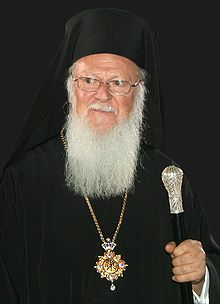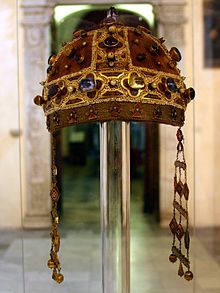Kamilavkion
The kalimavkion or Kamelaukion is from the Late Antiquity originating headgear , which is still in its today Orthodox churches is used.
etymology
The Greek variant of the name Kamelaukion is already documented in late antiquity . The Greek word τὸ καλυμμαυχῖον is a compound of τὸ κάλυμμα "covering" (to the verb καλύπτω "to hide") and ὁ αὐχήν "neck" and actually means "neck cover".
The modern Greek Kamilavkion or the Russian name Kamilawka come from the later adaptation "from camel hair" and is Slavic folk etymology . It is based on the fact that this covering of the Orthodox clergy was also made from camel hair in the course of their later history.
Kamelaukion in antiquity
The camel akion was created from a hood with a neck band in the later period of the Byzantine Empire and was the crown of the Byzantine emperors . It was a magnificent dome, decorated with pearls and precious stones and side drooping pendilia .
The neck band of the predecessor of the camel acion originally had the task of covering the bare neck of the basileus as an appendage of the crown , because necks only showed the subjugated. The camelaucuses themselves no longer had such neck ties.
Of all the ancient camels, only the copy of Constance of Aragón has survived, which however did not belong directly to a Byzantine ruler, but was used at the court of Sicily, which had imitated the Byzantine court in many ways.
Kamilavkion in the Roman Catholic Faith
The papal Kamilavkion is known as Camauro .
Kamilavkion in the Orthodox Faith

In the Orthodox churches , the Kamilavkion is the headgear of the secular clergy and the monks and bishops (the latter two also wear a veil over it).
The Kamilavkion is cylindrical and in the churches of Greek tradition black and for non-monks with a brim, while monks - and thus also the bishops who always belong to the monastic class - wear a veil falling backwards (Greek epinokamilvchion) on official occasions over the Kamilavkion , which in the Russian tradition is usually firmly connected to the kamilavkion and is not removed. This monastic headgear is called in Russian klobuk .
While in the Greek tradition all deacons and priests wear the kamilavkion in everyday life and also for many parts of the worship service, the Russian " Kamilavka " is an award for particularly honored priests and deacons. It is also not simply black, but made of red-purple velvet and has no brim.
Simple Russian Orthodox priests, deacons and monks wear a foldable, mostly black cap, called " Skufja ". However, this is usually only worn outside of the service. The right to wear the Skufja in certain parts of the service is already the lowest of the honors in the Russian Orthodox Church for priests.
Leading bishops of some churches wear a white veil over the kamilavkion or a white klobuk (e.g. the patriarchs in the Russian and Romanian traditions).
gallery
Orthodox cleric from Jerusalem with Kamilavkion
Ambrosius von Optima (1812-1891), a saint of the Russian Orthodox Church with Kamilavkion
Patriarch Daniel Ciobotea with white Kamilavkion
Patriarch Kyrill I with white Kamilavkion 2006 in Moscow
literature
- Karel C. Innemée, Heinzgerd Brakmann: Art. Kamelaukion. In: Real Lexicon for Antiquity and Christianity . Vol. 19, Hiersemann Verlag, Stuttgart 2003, Sp. 1241-1248.
- Dieter Philippi: Philippi Collection - Headgear in Faith, Religion and Spirituality . St. Benno Verlag, Leipzig, 2009, ISBN 978-3-7462-2800-6 . .
Web links
- Philippi collection - models, designs, variants and colors . Pictures, information and references to Kamilavkion.






